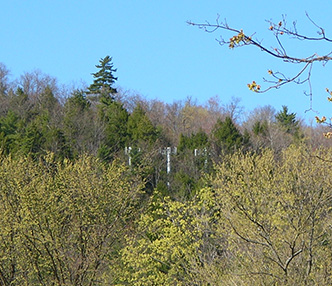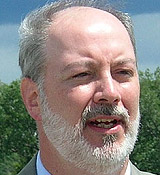
Feds Preserve Local & Adirondack Park Agency Jurisdiction over Size, Shape of Cell Towers
Tuesday, November 4, 2014
By: John F. Sheehan
This blog first appeared in the Adirondack Almanack on Oct. 29.
A coalition of New York’s environmental and historic preservation organizations is expressing its gratitude this week after receiving a decision from Federal Communications Commission (FCC) that preserves the rights of state and local governments to regulate the size, shape and visibility of telecommunications towers in scenic and historic areas, including the Adirondack Park.
In Jan uary, the groups sent a joint letter to the FCC, urging federal officials to recognize that scenic beauty and historic significance are the backbone of local tourism, both inside and outside of the Adirondack Park. In public comments on a proposed FCC rule, they asked the commissioners to reject the notion that expansions of 10 percent or more in the height or width of cell towers would have no impact on the environment or historic preservation.
uary, the groups sent a joint letter to the FCC, urging federal officials to recognize that scenic beauty and historic significance are the backbone of local tourism, both inside and outside of the Adirondack Park. In public comments on a proposed FCC rule, they asked the commissioners to reject the notion that expansions of 10 percent or more in the height or width of cell towers would have no impact on the environment or historic preservation.
The groups all recognize that the Adirondack Park, and other scenic areas, needs cell towers, just not ugly cell towers. The Adirondack Park is a mixture of public and private lands that includes the homes and businesses of 130,000 permanent residents and 10 million annual visitors, who need access to modern telecommunications. But the Park also depends on its wilderness character to attract those millions of visitors and hundreds of thousands of seasonal residents each year.
Since 2002, the Adirondack Park Agency’s outstanding policy on telecommunications towers has been a model for the entire nation. It has allowed rapid expansion of cell phone and broadband service, while screening new towers to preserve the wild and historic character of the Adirondack Park and its communities.
In short, the APA has done an excellent job of ensuring that new towers fit into the surrounding landscape and that the landscape is not alerted to accommodate the new towers.
Cell phone and broadband companies both report that they have faced no unreasonable regulatory delays. That is success. It was important for the FCC to recognize and encourage that success.
In addition, this ruling will help preserve the integrity of historic sites and communities across New York, whose residents have worked hard to protect their rich heritage and unique charm. Many areas of New York boast stunning scenic beauty and have more than three centuries of culture to celebrate. Tourism is the number two industry statewide.
Today’s victory could easily have gone the other way.
In 2013, the FCC proposed new rules streamlining the approval process for minor expansions of telecommunications towers and equipment. The rules eliminate the need to seek local or state permission for the change in most cases. That would have eliminated the Park Agency’s jurisdiction over such tower expansions. The FCC would have granted automatic approval -- even if the expansion allowed a formerly concealed tower to dominate an otherwise natural or historic landscape.
However, the FCC’s recent ruling specifically excluded from automatic approval any proposed tower expansion that “would defeat the existing concealment elements of the tower or base station.” (See pg. 10 http://bit.ly/ZY6jYE).
So if a proposed expansion would make a concealed tower visible, the APA could still enforce its towers policy. That policy requires new installations to be “substantially invisible.”
In January, the Adirondack Council helped to organize a coalition of environmental and historic preservation organizations to send a letter to the FCC asking for an exception to the new rules.
Signing on to the letter were the Adirondack Council, Adirondack Mountain Club, Citizens Campaign for the Environment, Mohawk-Hudson Land Conservancy, NY Public Interest Research Group (NYPIRG), Parks & Trails New York, the Preservation League of New York, Protect the Adirondacks, Scenic Hudson and Sierra Club, Atlantic Chapter.
Also expressing support for the FCC’s decision today is the Central Adirondack Partnership (CAP-21).
The FCC ruling reinforces the fact that it can encourage speedy deployment of new communications technology without abolishing state and local jurisdiction over modifications to the size and shape of towers.
The organizations had not objected to new rules allowing the rapid expansion of low-profile, distributed-antenna systems for telecommunications, which would speed deployment of communications equipment on existing buildings and utility poles. They also did not object to new rules allowing temporary towers in some locations.
Under the new FCC rules, changes in height, construction materials and equipment configuration would be exempt from all local and state review, as long as the modification doesn’t “substantially change” the dimensions of the current structure. The rule defines the term substantially change for the first time. Tower alterations that “would defeat the existing concealment elements of the tower or base station” will continue to constitute a substantial change and cannot receive automatic approval under the new rules.
The new rules follow 2009 FCC Declaratory Ruling that required automatic approval of expansions of 10 percent -- or more under certain circumstances – in an effort to speed development of new technology nationwide.
In the Adirondack Park, state and local regulators long ago anticipated a conflict between those pressing for improved communications and those who value the wilderness character of the park’s landscapes, or the historic value of its communities and buildings. In 2002, the Adirondack Park Agency (APA) established standards to allow for rapid expansion of communications without allowing a significant impact on environmental, scenic or historic resources.
The APA enforces a requirement that all tall structures be “substantially invisible.” This generally means no open sky behind it when viewed from public places, without some means of blending it into its surroundings. In addition, individual communities have persuaded companies to use existing structures (steeples, water towers, chimneys, etc.) to conceal new installations.
In many cases, the state and local regulators have adjusted the tower height, location, and use of screening techniques to achieve desired communications coverage -- without slowing the rate of new installations or improvements.
Would you like to comment on what you've read or viewed? We'd love to hear from you. Please click to send us a message.

Born and raised in Troy, NY, John Sheehan is a graduate of Catholic Central High School and the State University at Albany (1985; BA). Before joining the Council's staff in 1990, John was the managing editor of the Malone Evening Telegram, just north of the Adirondack Park. Prior to that, he worked as journalist for the Troy Record, (Schenectady) Daily Gazette, Watertown Daily Times and Newsday.
For the past 20 years, John has been the voice of the Adirondack Council on radio and television, and on the pages of local, regional and national media. Sheehan has overseen the production of two films about the Council (The Adirondack Council, 1992; and, ACID RAIN: A Continuing National Tragedy, 1998), appeared in the independent film Inside the Blue Line (1993) and has produced a series of radio and television public service announcements with entertainers Bonnie Raitt (1994), Natalie Merchant (1997) and brothers/band mates Michael and Kevin Bacon (2009-10).
John is a regular guest lecturer at several New York colleges and universities, including Colgate University, Hobart & William Smith College, Hamilton College, Rensselaer Polytechnic Institute, Union College, Siena College, SUNY Albany, SUNY Binghamton, SUNY College of Environmental Science and Forestry (Syracuse), and SUNY Potsdam. He has also addressed dozens of local organizations including local Rotary and Kiwanis clubs and chambers of commerce, scientific societies and community forums.
John and his wife Deborah live in Albany and are seasonal residents of the Adirondack Park. Their daughter Hannah attends Albany public schools.




